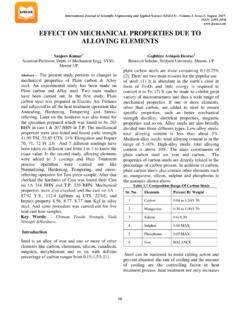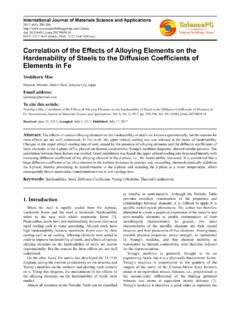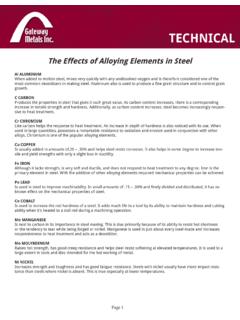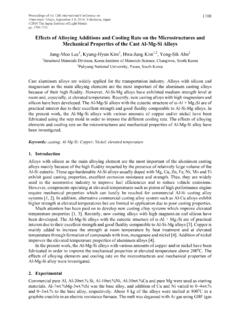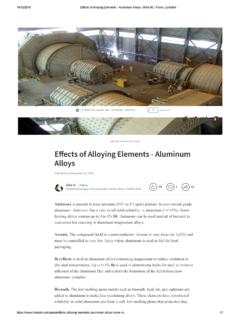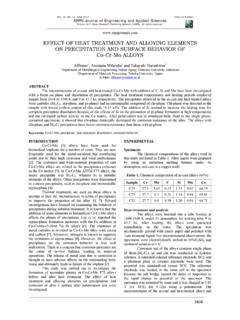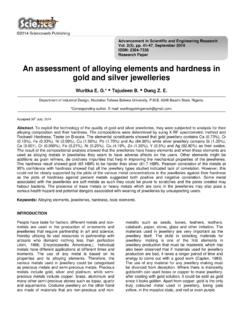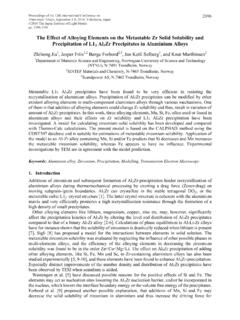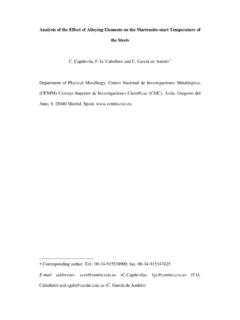Transcription of Effects of Alloying Elements in Aluminum Alloys and ...
1 Effects of Alloying Elements in Aluminum Alloys and Activationson Zincate treatment and electroless nickel - phosphorus PlatingKoji Murakami1, Makoto Hino1, Ryosuke Furukawa2;*and Teruto Kanadani21 Industrial Technology Research Institute of Okayama Prefectural Government, Okayama 701-1296, Japan2 Faculty of Engineering, Okayama University of Science, Okayama 700-0005, JapanZincate treatment and electroless nickel - phosphorus plating for Aluminum Alloys of A1100, A2017, A5052 and A7075 were researchedfrom the viewpoints of Alloying Elements and activation conducted prior to zincate treatment . Surface morphologies of zincated surfaces,electrochemical properties during zincate treatment and depth profiles on activated and zincated surfaces were investigated by microscopy andmeasurement of temporal changes of electrode strengths of the plated films were measured by 90 peeling test, which showed that double zincate treatment improved adhesionstrength especially when ferric ion was added into the zincate solution except for the case of A7075.
2 Temporal changes of electrode potentialduring zincate treatments and morphologies of the zincated surfaces showed that copper and zinc promoted uniform precipitation of zinc andresulting rapid termination of conversion reaction. Excess zinc was shown to dissolve into the plating solution and cause the formation of low-density area or gaps between plated films and for A1100 by various conditions showed that formation of oxide film had a remarkable effect on precipitation of zinc duringzincate treatment . When a mixture of nitric and hydrofluoric acid was used for activation, finer particles of zinc were formed near etch pitscompared with the cases of hydrochloric or nitric acid. On the other hand, the surface was uniformly covered with fine zinc particles in the caseof the activation with a solution of sodium hydroxide. This indicates that uniformity of oxide film on substrate before zincate treatment is thoughtto bring about uniform precipitation of zinc.[ ](Received August 17, 2009; Accepted September 28, 2009; Published December 2, 2009)Keywords: Aluminum Alloys , zincate treatment , electroless nickel - phosphorus plating , Alloying Elements , activation1.
3 IntroductionIndustrial application of Aluminum Alloys has beenexpanding for advantages of their light weight, workability,and excellent corrosion resistance. In order to improve theirsurface properties such as wear resistance, corrosion resist-ance or ornamentation, platings on Aluminum Alloys arecommonly adopted. As one of the measures to improvesurface properties of Aluminum Alloys , electroless nickel - phosphorus plating1 4)is promising for its excellent corrosionresistance as well as high hardness of HV600 and wearresistance. Recently, corrosion of Aluminum by bio-fuels5 8)has become of interest in automotive applications, which ishopefully suppressed by nickel -based Aluminum is such an active element as to be oxidizedand passivated in water9)as well as in air, poor adhesion ofplated films to substrates is one of the problems in )The most common solution for ensuring goodadhesion of plated films is the double zincate treatment 11)inwhich a conversion treatment is repeated twice in an alkalinezincate solution prior to plating .
4 electroless nickel -phospho-rus plating also requires the double zincate treatment forimprovement of adhesion strength. Although behavior ofalloying Elements in Aluminum Alloys has been consideredto be important for understanding adhesion of plated filmsto substrates, the detailed nature remains unknown whichaffects the interfacial structure between electroless nickel - phosphorus plated films and this research, adhesion strengths of electroless nickel - phosphorus plated films to commercial Aluminum Alloys werequantified for various zincate treatment conditions. Also,morphologies of zincate films and their formation processwere related to activation conducted prior to zincate treat-ment and to adhesion strengths of plated films by microscopyand electrochemical measurement. Here, electroless nickel - phosphorus plating and electroless nickel - phosphorus platedfilm are expressed as plating and plated film in thefollowing sentences unless otherwise ExperimentalRolled sheets of commercial Aluminum Alloys (JapanIndustrial Standard, JIS A1100P (99 mass%Al), A2017P( ), A5052P ( ), A7075P ( ))were used as substrate.
5 Chemical composition of each alloy isshown in Table 1. Adhesion strengths of plated films wereevaluated according to the previous ,13)The sub-strates were cut into platelets of a dimension of35 10mm2,then, each platelet was polished to a mirror finish by buffingto eliminate anchoring effect on adhesion of the plated filmsto the substrates and also to enhance the changes of adhesionstrength with respect to the condition of zincate to plating , pretreatments (alkaline degreasing, acti-vation and zincate treatment ) were carried out as shown inTable 1 Chemical compositions of Fe Cu Mn Mg Cr Zn Ti ZrA1100P H14 T3 H34 T651 *Undergraduate Student, Okayama University of Science. Present address:Yodogawa Steel Works Ltd., Osaka 541-0054, JapanMaterials Transactions, Vol. 51, No. 1 (2010) pp. 78 to 84#2010 The Japan Institute of Light MetalsTable 2. Here, a mixed solution of nitric acid and hydro-fluoric acid (volume ratio HNO3:HF 3:1) was used foractivation in the measurement of adhesion strength of theplated films.
6 This mixed solution, which is standard pre- treatment , is expressed as nitric-hydrofluoric acid in thefollowing zincate solutions, a basic solution and a ferric ion-added one were used for investigating the difference inproperties of zincate films as well as adhesion strengthsof plated films. The basic solution consists of zinc oxide(40 kg/m3-solution) and sodium hydroxide (240 kg/m3-solution),14,15)and the concentration of iron in the ferricion-added solution was set as Zn:Fe 40 : 1in )For adding ferric ion into the basic zincate solution, asolution of iron(III) chloride and a complexing agent for zinc-iron plating (Nippon Hyoumen Kagaku, Co., Ltd., Stronzinc)was used. Zincate treatment was conducted at 298 K for 30 s,and double zincate films were obtained by zincate treatmentafter removing single zincate films with a solution of 5 vol%nitric acid. Immediately after the pretreatments, eachsubstrate was immersed in an electroless nickel -phosphorusplating solution (Japan KANIGEN Co.
7 , Ltd., SD200), and theplating was conducted at363 3K for ks. The averagedthickness of the plated films obtained under the aboveconditions was plating , a 90 peeling test was carried out forquantification of adhesion strength of the plated ,13)Before the peeling test, the specimens were coated withcopper film of 30mm-thick by electroplating in coppersulfate solution for reinforcement of the electroless nickel - phosphorus plated films. After the side planes of the copper-coated substrates were polished by abrasive papers (#1200),the plated films were peeled with the cross head speed mm/s. Adhesion strength was conveniently determinedhere as the value of the maximum load divided by the widthof the peeled film (10 mm).Electrochemical properties of the surfaces of the substratesduring zincate treatment were investigated by measuringelectrode ,17 19)The polished substrates werecovered with epoxy resin, leaving square windows of10 10mm2which contact the zincate solutions. Afterdegreasing and pickling, each substrate was immersed intothe basic zincate solution or the ferric ion-added one, and thepotential was measured by using a salt bridge of saturatedpotassium chloride and a standard calomel electrode (SCE)as a surfaces of the substrates after zincate treatments wereobserved by field emission scanning electron microscopy(FE-SEM).
8 Element analysis on the surfaces was conductedby Auger electron spectroscopy (AES). Depth profiles of theactivated or zincated surfaces were obtained by using argonion etching whose acceleration voltage and sputtering ratewere 3 kV and nm/cycle, Experimental Adhesion strength of plated filmFigure 1 shows adhesion strengths of the plated adhesion strengths are generally low in the case ofthe basic zincate solution (Fig. 1(a)), that of 5052 (doubleTable 2 Conditions of zincateDouble zincateUltrasonic cleaningDegreasingActivationSingle zincatein acetone 300 s####HNO3:HF 3:15 sBasic solutionPicklingWater rinseor(NaOH 240 kg/m3(5 vol% HNO3)#50 vol% HNO330 s+ ZnO 40 kg/m3)10sAlkaline degreasingoror#(NaCO320 kg/m3+50 vol% HCl 30 sFerric ion-added solutionZincateNa2 SiO310 kg/m3)or(Zincate:Ferric complex#150 s1 kmol/m3 NaOH 30 s=40 : 1in mol)Water rinse##298 K, 30 sWater rinseWater rinse #Water rinse Water rinse is not conducted in the case of sodium 1 Adhesion strengths of plated films on substrates.)
9 (a) Basic zincatesolution, (b) Ferric ion-added of Alloying Elements in Aluminum Alloys and Activations on Zincate treatment and electroless nickel - phosphorus Plating79zincate treatment ) is remarkably higher than other using the ferric ion-added zincate solution (Fig. 1(b)),adhesion strengths were improved for all substrates. Here, fora plated film which ruptured during the peeling tests, Filmruptured is denoted in the corresponding bar. On the otherhand, for a specimen whose plated film peeled off before thepeeling test, Film peeled off is the other hand, adhesion strengths were generallypoor in the case of A7075 compared with other plated films could be peeled continuously even for thespecimens which underwent the double zincate treatmentwith the ferric ion-added Temporal change of electrode potential duringzincate treatmentFigure 2 shows the temporal changes of electrode potentialduring zincate treatments. The curves during the singlezincate treatments of A1100 and A5052 with the basicsolution (Fig.
10 2(a),(c)) show almost the same tendency, inwhich rather slow rises of electrode potential at the beginningare observed. The electrode potentials of A1100 and A5052are rapidly stabilized for the double zincate the other hand, the potential curves of A2017 andA7075 in the case of the basic zincate solution (Fig. 2(b),(d))are almost the same for both the single and the double zincatetreatments, and the potentials are stabilized in a few secondsafter the substrates are immersed into the solution. By usingthe ferric ion-added zincate solution (Fig. 2(e) (h)), theinitial potentials are shifted to less-noble side compared withthe cases of the basic solution, but the tendency is almostthe same as that of Fig. 2(a) (d). Morphology of zincated surfaceFigure 3 shows secondary electron images of the surfacesafter zincate treatment with the basic solution. The surfacemorphologies of A1100 and A5052 after zincate treatment (Fig. 3(a) (c) and (g) (i)), whose temporal changes ofelectrode potential showed almost the same tendency, weresimilar, showing rather coarse zinc particles of 500nmaround the etch pits at the beginning of the single zincateFig.








